Decorah, Iowa
Decorah is a city in and the county seat of Winneshiek County, Iowa, United States.[5] The population was 8,127 at the 2010 census. Decorah is located at the intersection of State Highway 9 and U.S. Route 52, and is the largest community in Winneshiek County.
Decorah, Iowa | |
|---|---|
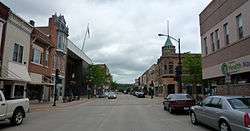 Downtown Decorah | |
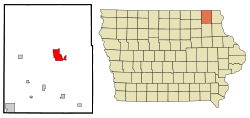 Location of Decorah, Iowa | |
| Coordinates: 43°18′6″N 91°47′25″W | |
| Country | |
| State | |
| County | Winneshiek |
| Government | |
| • Mayor | Lorraine Borowski[1] |
| Area | |
| • Total | 7.15 sq mi (18.53 km2) |
| • Land | 7.11 sq mi (18.41 km2) |
| • Water | 0.04 sq mi (0.11 km2) |
| Elevation | 879 ft (268 m) |
| Population | |
| • Total | 8,127 |
| • Estimate (2019)[4] | 7,576 |
| • Density | 1,065.54/sq mi (411.41/km2) |
| Time zone | UTC-6 (Central (CST)) |
| • Summer (DST) | UTC-5 (CDT) |
| ZIP code | 52101 |
| Area code(s) | 563 |
| FIPS code | 19-19405 |
| GNIS feature ID | 0455839 |
| Website | www |
History
Decorah was the site of a Ho-Chunk village beginning circa 1840. Several Ho-Chunks had settled along the Upper Iowa River that year when the U.S. Army forced them to remove from Wisconsin.[6] In 1848, the United States removed the Ho-Chunks again to a new reservation in Minnesota, opening their Iowa villages to white settlers. The first whites to settle were the Day family from Tazewell County, Virginia. According to local Congregationalist minister Rev. Ephraim Adams, the Days arrived in June 1849 with the Ho-Chunks' "tents still standing—with the graves of the dead scattered about where now run our streets and stand our dwellings."[7] Judge Eliphalet Price suggested that the Days name their new settlement Decorah after Ho-Chunk leader Waukon Decorah, who was a U.S. ally during the Black Hawk War of 1832.[8]
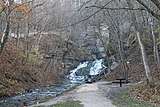
During the 1850s and 1860s, Decorah grew quickly as settlers built dams and mills to harness water power at Dunning's Spring and other local streams.[9] In 1851, the town became the county seat of Winneshiek County. Decorah also became the site of a U.S. Land Office from 1855 to 1856, making it a destination for immigrants seeking land patents in northern Iowa. The Milwaukee and St. Paul Railroad opened a branch to Decorah in 1869.[10]
Decorah has become a center for Norwegian-American culture originating from a high number of Norwegian settlements beginning in the 1850s. Since 1861 it has been the home of Luther College, a liberal arts institution affiliated with the Evangelical Lutheran Church in America. Each July Decorah is also the host of Nordic Fest, a celebration of Norwegian culture with ethnic dancing, food, and music. Decorah is also the home of the Vesterheim Norwegian-American Museum, the largest museum in the country devoted to one single immigrant group. Until 1972, one of the largest Norwegian language newspapers in the nation was published in Decorah, the Decorah Posten.
Geography
Decorah is located at 43°18′06″N 91°47′25″W (43.301795, -91.790218),[11] approximately 15 miles (24 km) south of the Minnesota-Iowa border. It is the northernmost major community located along U.S. Route 52 in Iowa. According to the United States Census Bureau, the city has a total area of 7.04 square miles (18.23 km2), of which 7.01 square miles (18.16 km2) is land and 0.03 square miles (0.08 km2) is water.[12] The Upper Iowa River flows through the city en route to the Upper Mississippi River. The river is faced by steep bluffs, characteristic of the Driftless Area.
Impact Crater
About 470 million years ago, an asteroid as big as a city block smashed into what is now Decorah, supporting a theory that a giant space rock broke up and bombarded Earth just as early life began flourishing in the oceans.[13]
The impact dug a crater nearly four miles wide that now lies beneath the town, said Bevan French, one of the world's foremost crater hunters and an adjunct scientist at the National Museum of Natural History.[13]
The Decorah crater lay undiscovered until recently because almost none of it is above ground. Instead, it is filled by an unusual shale that formed after an ancient seaway sluiced into the crater, depositing sediment and an array of bizarre sea creatures that hardened into fossils.[13] One such creature is Pentecopterus decorahensis, which was named for the city.[14]
Demographics
| Year | Pop. | ±% |
|---|---|---|
| 1860 | 1,920 | — |
| 1870 | 2,110 | +9.9% |
| 1880 | 2,951 | +39.9% |
| 1890 | 2,801 | −5.1% |
| 1900 | 3,246 | +15.9% |
| 1910 | 3,592 | +10.7% |
| 1920 | 4,039 | +12.4% |
| 1930 | 4,581 | +13.4% |
| 1940 | 5,303 | +15.8% |
| 1950 | 6,060 | +14.3% |
| 1960 | 6,435 | +6.2% |
| 1970 | 7,237 | +12.5% |
| 1980 | 8,068 | +11.5% |
| 1990 | 8,063 | −0.1% |
| 2000 | 8,172 | +1.4% |
| 2010 | 8,127 | −0.6% |
| 2019 | 7,576 | −6.8% |
| Source: "U.S. Census website". United States Census Bureau. Retrieved 2020-03-29. Source: | ||
2010 census
As of the census[3] of 2010, there were 8,127 people, 2,855 households, and 1,527 families living in the city. The population density was 1,159.3 inhabitants per square mile (447.6/km2). There were 3,121 housing units at an average density of 445.2 per square mile (171.9/km2). The racial makeup of the city was 94.6% White, 1.5% African American, 2.2% Asian, 0.6% from other races, and 1.0% from two or more races. Hispanic or Latino of any race were 2.0% of the population.
There were 2,855 households, of which 21.9% had children under the age of 18 living with them, 44.4% were married couples living together, 6.8% had a female householder with no husband present, 2.3% had a male householder with no wife present, and 46.5% were non-families. 38.5% of all households were made up of individuals, and 18.7% had someone living alone who was 65 years of age or older. The average household size was 2.09 and the average family size was 2.76.
The median age in the city was 29.6 years. 14.3% of residents were under the age of 18; 32.1% were between the ages of 18 and 24; 15.3% were from 25 to 44; 19.5% were from 45 to 64; and 18.7% were 65 years of age or older. The gender makeup of the city was 46.1% male and 53.9% female.
2000 census
As of the census[16] of 2000, there were 8,172 people, 2,819 households, and 1,561 families living in the city. The population density was 1,275.9 people per square mile (492.2/km2). There were 2,968 housing units at an average density of 463.4 per square mile (178.8/km2). The racial makeup of the city was 95.99% White, 1.13% African American, 0.10% Native American, 1.60% Asian, 0.01% Pacific Islander, 0.42% from other races, and 0.76% from two or more races. Hispanic or Latino of any race were 1.30% of the population. 34.0% were of Norwegian, 30.3% German, 5.4% English and 5.2% Irish ancestry according to Census 2000.
There were 2,819 households, out of which 22.9% had children under the age of 18 living with them, 46.9% were married couples living together, 6.6% had a female householder with no husband present, and 44.6% were non-families. 37.1% of all households were made up of individuals, and 18.1% had someone living alone who was 65 years of age or older. The average household size was 2.13 and the average family size was 2.80.
In the city the population was spread out, with 15.0% under the age of 18, 31.4% from 18 to 24, 17.8% from 25 to 44, 17.0% from 45 to 64, and 18.8% who were 65 years of age or older. The median age was 30 years. For every 100 females, there were 81.6 males. For every 100 females age 18 and over, there were 78.5 males.
The median income for a household in the city was $37,485, and the median income for a family was $49,668. Males had a median income of $33,362 versus $22,399 for females. The per capita income for the city was $16,351. About 2.7% of families and 8.0% of the population were below the poverty line, including 2.9% of those under age 18 and 9.4% of those age 65 or over.
Economy
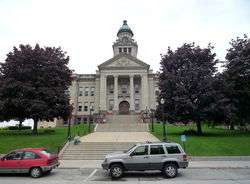
Decorah serves as the county seat of Winneshiek County, which is a major employer. The county courthouse was built in 1903.[17] Decorah's largest employer is Luther College, in addition to several national corporations. Because Winneshiek County's economy is primarily based on farming, Decorah serves as an agricultural hub. Decorah is also home to Seed Savers Exchange, an heirloom plant farm and preservation organization.[18]
Parks and recreation
Each July Decorah is the home of Nordic Fest, a celebration of Norwegian culture. Decorah is also the home of the Vesterheim Norwegian-American Museum. This museum is the largest Norwegian museum in the United States.
Natural features include Dunning's Spring,[19] Ice Cave, and Siewers Spring. The city is home to several parks built on bluffs, particularly Phelps Park, Palisades Park, and Pulpit Rock. Until 2003, Decorah had a community ski area, the Nor-Ski Runs Ski Area.
Decorah is home to an operating trout hatchery[20] as well as Twin Springs Park, the former home of the hatchery.
The Raptor Resource Center is located in Decorah. Each year they host a livestreamed webcam of a family of nesting bald eagles as they rear their young.
Education
Decorah is part of the Decorah Community School District in Winneshiek County.[21] The high school is Decorah High School, and the mascot is the Vikings.
St. Benedict School of the Roman Catholic Archdiocese of Dubuque is in Decorah. It opened in 1885 in a two story, four room frame building. The school, with five nuns as teachers, was initially until high school but in 1919 became an elementary-middle school only. The convent, which had a second-floor bridge to the original school building, was renovated to be the second school building. In 1964 the current school was built for $268,000 in southern Decorah. A new addition was established in the 1980s, with a music room, a storage and teaching aid area, and two classrooms.[22]
Decorah is also home to Luther College, a private four-year residential college affiliated with the Evangelical Lutheran Church in America and known especially for their Nordic Choir.[23] Their mascot is "The Norse."
Media
Newspaper: The community newspaper is printed twice a week in Decorah - The Decorah Journal and Decorah Public Opinion. Newspaper office location: 107 East Water St., Decorah, IA 52101. Telephone: 563-382-4221.
Web: The local independent news web site is Decorah News.[24]
Radio
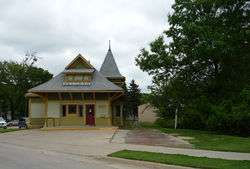
- KLNI 88.7 (Minnesota Public Radio News)
- KPVL 89.1 (Studios in both Postville and Decorah)
- KLCD 89.5 (Classical Minnesota Public Radio)
- K247BF-LP 97.3 (Translator for KWVI)
- K257CI-LP 99.3 (Translator for KQYB-FM)
- KDHK 100.5
- K268AF-LP 101.5 (Translator for KFSI)
- KVIK 104.7 "The Viking"
- KDEC 1240
- KWLC 1240 (Luther College)
Other nearby stations Include:
Notable people
- Laurie Hurst, Dirt Racing Fan
- Josey Jewell, NFL linebacker, Denver Broncos
- Ephraim Douglass Adams, Stanford historian
- Theodora Cormontan, Norwegian-American pianist
- William Foege, epidemiologist
- Edward L. Garden, North Dakota politician
- Georgann Johnson, actress
- John Brayshaw Kaye, poet and politician
- Weston Noble, music educator
- Mark Pinter, actor
- Jerry Reichow, nine-year NFL veteran, offensive end for 1957 champion Detroit Lions
- Dean Schwarz, American Potter and Painter
- Oswald Veblen, mathematician, geometer and topologist
- Johannes B. Wist, journalist
References
- "Mayor & City Council | City of Decorah Iowa". City of Decorah Iowa. Retrieved 2018-11-09.
- "2019 U.S. Gazetteer Files". United States Census Bureau. Retrieved July 17, 2020.
- "U.S. Census website". United States Census Bureau. Retrieved 2012-05-11.
- "Population and Housing Unit Estimates". United States Census Bureau. May 24, 2020. Retrieved May 27, 2020.
- "Find a County". National Association of Counties. Archived from the original on 2011-05-31. Retrieved 2011-06-07.
- Whittaker, William E. (10 March 2016). "An Analysis of Historic-Era Indian Locations in Iowa". Midcontinental Journal of Archaeology. 41 (2): 159–185. doi:10.1080/01461109.2016.1156799.
- Sparks, Charles H. (1877). History of Winneshiek County, with Biographical Sketches of its Eminent Men. Decorah, Ia: Jas. Alex. Leonard. p. 87.
- Alexander, W.E. (1882). History of Winneshiek and Allamakee Counties Iowa. Sioux City, Ia.: Western Publishing Co. pp. 141–142, 269.
- Faldet, David S. (2009). Oneota Flow: the Upper Iowa River and its people. Iowa City: University of Iowa Press. pp. 104–105. ISBN 9781587298363.
- Alexander (1882), pp. 190-191, 249, 271-272.
- "US Gazetteer files: 2010, 2000, and 1990". United States Census Bureau. 2011-02-12. Retrieved 2011-04-23.
- "US Gazetteer files 2010". United States Census Bureau. Archived from the original on 2012-01-25. Retrieved 2012-05-11.
- Vastag, Brian (2013-02-18). "Crater found in Iowa points to asteroid break-up 470 million years ago". The Washington Post.
- Lamsdell, James C.; Briggs, Derek E. G.; Liu, Huaibao; Witzke, Brian J.; McKay, Robert M. (1 September 2015). "The oldest described eurypterid: a giant Middle Ordovician (Darriwilian) megalograptid from the Winneshiek Lagerstätte of Iowa". BMC Evolutionary Biology. 15: 169. doi:10.1186/s12862-015-0443-9. PMC 4556007. PMID 26324341.
- "Census of Population and Housing". Census.gov. Retrieved 2015-06-04.
- "U.S. Census website". United States Census Bureau. Retrieved 2008-01-31.
- Ms.Hegstrom. "Iowa Courthouses". iowacourthouses.blogspot.com. Retrieved 27 January 2016.
- "Seed Savers Exchange - Saving America's Heirloom Seeds". seedsavers.org. Retrieved 27 January 2016.
- "Environmental Studies". luther.edu. Retrieved 27 January 2016.
- "Decorah Fish Hatchery". iowadnr.gov. Archived from the original on 21 June 2012. Retrieved 27 January 2016.
- "Home - Decorah Community School District". decorah.k12.ia.us. Retrieved 27 January 2016.
- "History of St. Benedict School". St. Benedict School. 2003-10-28. Archived from the original on 2003-10-28. Retrieved 2020-04-07.
- "Luther College". luther.edu. Retrieved 27 January 2016.
- "Decorah news NOW! Local news, weather, sports & information". decorahnews.com. Retrieved 2018-08-01.
- Schwieterman, Joseph P. (2004). When the Railroad Leaves Town: American Communities in the Age of Rail Line Abandonment, Western United States. Kirksville, Missouri: Truman State University Press. pp. 136–139. ISBN 978-1-931112-13-0.
External links
| Wikimedia Commons has media related to Decorah, Iowa. |
- City website
- Decorah Newspapers
- Decorah Community Schools
- City Data Comprehensive Statistical Data and more about Decorah, Iowa